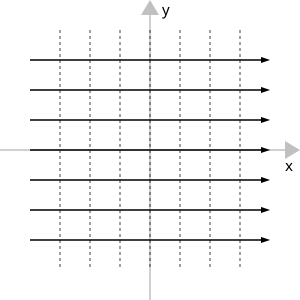Elementary flow
This article has multiple issues. Please help improve it or discuss these issues on the talk page. (Learn how and when to remove these messages)
|
Elementary flow is a collection of basic flows from which it is possible to construct more complex flows by superposition. Some of the flows reflect specific cases and constraints such as incompressible or irrotational flows, or both, as in the case of potential flow.[1]
Two-dimensional uniform flow

Given a uniform velocity of a fluid at any position in space:
This flow is incompressible because the velocity is constant, the first derivatives of the velocity components are zero, and the total divergence is zero:
Given the circulation is always zero the flow is also irrotational, we can derive this from the Kelvin's circulation theorem and from the explicit computation of the vorticity:
Being incompressible and two-dimensional, this flow is constructed from a stream function:
from which
and in cylindrical coordinates:
from which
As usual the stream function is defined up to a constant value which here we take as zero. We can also confirm that the flow is irrotational from:
Being irrotational, the potential function is instead:
and therefore
and in cylindrical coordinates
Two-dimensional line source

The case of a vertical line emitting at a fixed rate a constant quantity of fluid Q per unit length is a line source. The problem has a cylindrical symmetry and can be treated in two dimension on the orthogonal plane.
Line sources and line sinks (below) are important elementary flows because they play the role of monopole(s) for incompressible fluids (which can also be considered examples of solenoidal fields i.e. divergence free fields). Generic flow patterns can be also de-composed in terms of multipole expansions, in the same manner as for electric and magnetic fields where the monopole is essentially the first non-trivial (e.g. constant) term of the expansion.
This flow pattern is also both irrotational and incompressible.
This is characterized by a cylindrical symmetry:
Where the total outgoing flux is constant
Therefore,
This is derived from a stream function
or from a potential function
Two-dimensional line sink
The case of a vertical line absorbing at a fixed rate a constant quantity of fluid Q per unit length is a line sink. Everything is the same as the case of a line source a part from the negative sign.
This is derived from a stream function
or from a potential function
Given that the two results are the same a part from a minus sign we can treat transparently both line sources and line sinks with the same stream and potential functions permitting Q to assume both positive and negative values and absorbing the minus sign into the definition of Q.
Two-dimensional doublet or dipole line source

If we consider a line source and a line sink at a distance d we can reuse the results above and the stream function will be
The last approximation is to the first order in d.
Given
It remains
The velocity is then
And the potential instead
Two-dimensional vortex line

This is the case of a vortex filament rotating at constant speed, there is a cylindrical symmetry and the problem can be solved in the orthogonal plane.
Dual to the case above of line sources, vortex lines play the role of monopoles for irrotational flows.
Also in this case the flow is also both irrotational and incompressible and therefore a case of potential flow.
This is characterized by a cylindrical symmetry:
Where the total circulation is constant for every closed line around the central vortex
and is zero for any line not including the vortex.
Therefore,
This is derived from a stream function
or from a potential function
Which is dual to the previous case of a line source
Generic two-dimensional potential flow
Given an incompressible two-dimensional flow which is also irrotational we have:
Which is in cylindrical coordinates [2]
We look for a solution with separated variables:
which gives
Given the left part depends only on r and the right parts depends only on , the two parts must be equal to a constant independent from r and . The constant shall be positive[clarification needed]. Therefore,
The solution to the second equation is a linear combination of and In order to have a single-valued velocity (and also a single-valued stream function) m shall be a positive integer.
therefore the most generic solution is given by
The potential is instead given by
References
- Fitzpatrick, Richard (2017), Theoretical fluid dynamics, IOP science, ISBN 978-0-7503-1554-8
- Faber, T.E. (1995), Fluid Dynamics for Physicists, Cambridge university press, ISBN 9780511806735
- Specific
- ^ Oliver, David (2013-03-14). The Shaggy Steed of Physics: Mathematical Beauty in the Physical World. Springer Science & Business Media. ISBN 978-1-4757-4347-0.
- ^ Laplace operator
Further reading
- Batchelor, G.K. (1973), An introduction to fluid dynamics, Cambridge University Press, ISBN 978-0-521-09817-5
- Chanson, H. (2009), Applied Hydrodynamics: An Introduction to Ideal and Real Fluid Flows, CRC Press, Taylor & Francis Group, Leiden, The Netherlands, 478 pages, ISBN 978-0-415-49271-3
- Lamb, H. (1994) [1932], Hydrodynamics (6th ed.), Cambridge University Press, ISBN 978-0-521-45868-9
- Milne-Thomson, L.M. (1996) [1968], Theoretical hydrodynamics (5th ed.), Dover, ISBN 978-0-486-68970-8
External links
- Richard Fitzpatrick University of Texas, Austin (2017). "Fluid Mechanics". University of Texas, Austin. Retrieved 2018-02-07.
- (c) Aerospace, Mechanical & Mechatronic Engg. 2005 University of Sydney (2005). "Elements of Potential Flow". University of Sydney. Retrieved 2019-04-19.
{{cite web}}: CS1 maint: numeric names: authors list (link)


























![{\displaystyle \mathbf {d} =d[\cos(\theta _{0})\mathbf {e} _{x}+\sin(\theta _{0})\mathbf {e} _{y}]=d[\cos(\theta -\theta _{0})\mathbf {e} _{r}+\sin(\theta -\theta _{0})\mathbf {e} _{\theta }]}](https://wikimedia.org/api/rest_v1/media/math/render/svg/4f744347082941ed6ebc3b920e9b714e16fdb8f3)

















![{\displaystyle \psi =\alpha _{0}+\beta _{0}\ln r+\sum _{m>0}{\left(\alpha _{m}r^{m}+\beta _{m}r^{-m}\right)\sin {[m(\theta -\theta _{m})]}}}](https://wikimedia.org/api/rest_v1/media/math/render/svg/91e2e00a53ef74b71c0c182739700e67630247bd)
![{\displaystyle \phi =\alpha _{0}-\beta _{0}\theta +\sum _{m\mathop {>} 0}{(\alpha _{m}r^{m}-\beta _{m}r^{-m})\cos {[m(\theta -\theta _{m})]}}}](https://wikimedia.org/api/rest_v1/media/math/render/svg/4ae11d9c0fa83d2856902127f9cd620c057980ee)